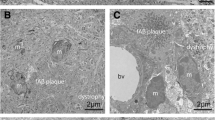Abstract
Elevated concentrations of aluminum are found in regions of neurofibrillary change in brains with senile or presenile dementia of Alzheimer’s type. The concentrations of aluminum found in the human disease are comparable to those found in experimental animals with aluminum-induced neurofibrillary degeneration (NFD). Although there are a number of reports confirming these observations, two laboratories have been unable to detect elevated levels in Alzheimer’s disease. We conducted an interlaboratory study to resolve this discrepancy and traced the discrepancy to difficulties in analytical procedures. We concluded that failure to detect elevated aluminum levels associated with NFD is the result of (a) lack of strict adherence to the criteria for sample selection; (b) selection of too large a sample for analysis; and (c) use of analytical methodology that has potential matrix interference for the measured signal.
Similar content being viewed by others
References
D. R. Crapper, S. S. Krishnan, and A. J. Dalton,Science 180, 511 (1973).
D. R. Crapper, S. S. Krishnan, and S. Quittkat,Brain 99, 67 (1976).
D. R. Crapper, S. Karlik, and U. De Boni,Alzheimer’s Disease: Senile Dementia and Related Disorders, Aging, vol. 7, R. Katzman, R. D. Terry, and K. L. Bick, eds., Raven, New York, NY, 1978.
G. R. Trapp, G. D. Miner, R. L. Zimmerman, R. A. Mastri, and L. L. Helstron,Biol. Psychol. 13, 709 (1978).
D. R. Crapper, S. Quittkat, S. S. Krishnan, A. J. Dalton, and U. De Boni,Acta Neuropathol. 50, 19 (1980).
D. P. Perl and A. R. Brody,Science 208, 297 (1980).
D. P. Perl, D. C. Gajdusek, R. M. Garruto, R. Yanagihara, and C. V. Gibbs,Science 217, 1053 (1983).
W. R. Markesbury, W. D. Ehmann, T. I. M. Hossaim, M. Alauddin, and D. T. Goodin,Ann. Neurol. 10, 511 (1981).
J. R. McDermott, A. I. Smith, K. Iqbal, and H. M. Wisniewski,Neurology 29, p. 809 (1979).
K. Fritze and R. Robertson,J. Radioanal. Chem. 7, 213 (1971).
S. S. Krishnan, S. Quittkat, and D. R. Crapper,Can. J. Spectroscopy 21, 1, 25 (1976).
R. D. Terry, Albert Einstein’s School of Med., Dept. of Path., Personal Communication (1980).
Author information
Authors and Affiliations
Rights and permissions
About this article
Cite this article
Krishnan, S.S., Harrison, J.E. & McLachlan, D.R.C. Origin and resolution of the aluminum controversy concerning Alzheimer’s neurofibrillary degeneration. Biol Trace Elem Res 13, 35–42 (1987). https://doi.org/10.1007/BF02796619
Issue Date:
DOI: https://doi.org/10.1007/BF02796619




